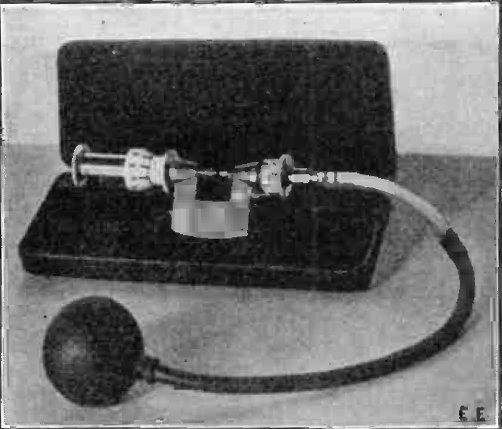|
Friedrich Bezold
Friedrich Bezold (9 February 1842 – 5 October 1908) was a German otologist and professor at the University of Munich. He made several contributions to early audiology. He is best known for developing hearing tests with tuning forks and his work to improve education for the hearing impaired. He was also the first physician to provide a clear understanding of mastoiditis. The following medical terms are named after him: * Bezold's abscess * Bezold's mastoiditis: mastoiditis with perforation into the gigastric groove that creates a deep neck abscess. * Bezold's sign: indication of descending mastoiditis * Bezold's test: method of testing deafness by use of a tuning fork * Bezold's triad: Three symptomatic indications of otosclerosis: 1. diminished aural perception of low frequency tones, 2. retarded bone conduction, 3. negative Rinne test * Bezold-Edelmann continuous scale: A series of tuning forks along with Galton's whistle or monochord, in which all perceptible notes can b ... [...More Info...] [...Related Items...] OR: [Wikipedia] [Google] [Baidu] |
Friedrich Bezold
Friedrich Bezold (9 February 1842 – 5 October 1908) was a German otologist and professor at the University of Munich. He made several contributions to early audiology. He is best known for developing hearing tests with tuning forks and his work to improve education for the hearing impaired. He was also the first physician to provide a clear understanding of mastoiditis. The following medical terms are named after him: * Bezold's abscess * Bezold's mastoiditis: mastoiditis with perforation into the gigastric groove that creates a deep neck abscess. * Bezold's sign: indication of descending mastoiditis * Bezold's test: method of testing deafness by use of a tuning fork * Bezold's triad: Three symptomatic indications of otosclerosis: 1. diminished aural perception of low frequency tones, 2. retarded bone conduction, 3. negative Rinne test * Bezold-Edelmann continuous scale: A series of tuning forks along with Galton's whistle or monochord, in which all perceptible notes can b ... [...More Info...] [...Related Items...] OR: [Wikipedia] [Google] [Baidu] |
Otosclerosis
Otosclerosis is a condition of the middle ear where portions of the dense enchondral layer of the bony labyrinth remodel into one or more lesions of irregularly-laid spongy bone. As the lesions reach the stapes the bone is resorbed, then hardened ( sclerotized), which limits its movement and results in hearing loss, tinnitus, vertigo or a combination of symptoms. The term otosclerosis is something of a misnomer: much of the clinical course is characterized by lucent rather than sclerotic bony changes, so the disease is also known as otospongiosis. Etymology The word ''otosclerosis'' derives from Greek ὠτός (''ōtos''), genitive of οὖς (''oûs'') "ear" + σκλήρωσις (''sklērōsis''), "hardening". Presentation The primary form of hearing loss in otosclerosis is conductive hearing loss (CHL) whereby sounds reach the ear drum but are incompletely transferred via the ossicular chain in the middle ear, and thus partly fail to reach the inner ear (cochlea). This can af ... [...More Info...] [...Related Items...] OR: [Wikipedia] [Google] [Baidu] |
1908 Deaths
Nineteen or 19 may refer to: * 19 (number), the natural number following 18 and preceding 20 * one of the years 19 BC, AD 19, 1919, 2019 Films * ''19'' (film), a 2001 Japanese film * ''Nineteen'' (film), a 1987 science fiction film Music * 19 (band), a Japanese pop music duo Albums * ''19'' (Adele album), 2008 * ''19'', a 2003 album by Alsou * ''19'', a 2006 album by Evan Yo * ''19'', a 2018 album by MHD * ''19'', one half of the double album ''63/19'' by Kool A.D. * ''Number Nineteen'', a 1971 album by American jazz pianist Mal Waldron * ''XIX'' (EP), a 2019 EP by 1the9 Songs * "19" (song), a 1985 song by British musician Paul Hardcastle. * "Nineteen", a song by Bad4Good from the 1992 album '' Refugee'' * "Nineteen", a song by Karma to Burn from the 2001 album ''Almost Heathen''. * "Nineteen" (song), a 2007 song by American singer Billy Ray Cyrus. * "Nineteen", a song by Tegan and Sara from the 2007 album '' The Con''. * "XIX" (song), a 2014 song by Slipk ... [...More Info...] [...Related Items...] OR: [Wikipedia] [Google] [Baidu] |
1842 Births
__NOTOC__ Year 184 ( CLXXXIV) was a leap year starting on Wednesday (link will display the full calendar) of the Julian calendar. At the time, it was known as the Year of the Consulship of Eggius and Aelianus (or, less frequently, year 937 ''Ab urbe condita''). The denomination 184 for this year has been used since the early medieval period, when the Anno Domini calendar era became the prevalent method in Europe for naming years. Events By place China * The Yellow Turban Rebellion and Liang Province Rebellion break out in China. * The Disasters of the Partisan Prohibitions ends. * Zhang Jue leads the peasant revolt against Emperor Ling of Han of the Eastern Han Dynasty. Heading for the capital of Luoyang, his massive and undisciplined army (360,000 men), burns and destroys government offices and outposts. * June – Ling of Han places his brother-in-law, He Jin, in command of the imperial army and sends them to attack the Yellow Turban rebels. * Winter – Zha ... [...More Info...] [...Related Items...] OR: [Wikipedia] [Google] [Baidu] |
Who Named It
''Whonamedit?'' is an online English-language dictionary of medical eponyms and the people associated with their identification. Though it is a dictionary, many eponyms and persons are presented in extensive articles with comprehensive bibliographies. The dictionary is hosted in Norway and maintained by medical historian Ole Daniel Enersen Ole Daniel Enersen (born March 14, 1943, in Oslo, Norway) is a Norwegian climber, photographer, journalist, writer, and medical historian. In 1965 he made the first ascent of the Trollveggen mountain in Romsdalen, Norway, along with Leif Norman .... References External links * Medical websites Medical dictionaries Eponyms {{online-dict-stub ... [...More Info...] [...Related Items...] OR: [Wikipedia] [Google] [Baidu] |
Monochord
A monochord, also known as sonometer (see below), is an ancient musical and scientific laboratory instrument, involving one (mono-) string ( chord). The term ''monochord'' is sometimes used as the class-name for any musical stringed instrument having only one string and a stick shaped body, also known as musical bows. According to the Hornbostel–Sachs system, string bows are bar zithers (311.1) while monochords are traditionally board zithers (314). The "harmonical canon", or monochord is, at its least, "merely a string having a board under it of exactly the same length, upon which may be delineated the points at which the string must be stopped to give certain notes," allowing comparison. A string is fixed at both ends and stretched over a sound box. One or more movable bridges are then manipulated to demonstrate mathematical relationships among the frequencies produced. "With its single string, movable bridge and graduated rule, the monochord (''kanōn'' reek: law stradd ... [...More Info...] [...Related Items...] OR: [Wikipedia] [Google] [Baidu] |
Galton's Whistle
A dog whistle (also known as silent whistle or Galton's whistle) is a type of whistle that emits sound in the ultrasonic range, which humans cannot hear but some other animals can, including dogs and domestic cats, and is used in their training. It was invented in 1876 by Francis Galton and is mentioned in his book ''Inquiries into Human Faculty and Its Development'',Galton, Francis (1883) ''Inquiries into Human Faculty and Its Development'' pp. 26-27. in which he describes experiments to test the range of frequencies that could be heard by various animals, such as a house cat. The upper limit of the human hearing range is about 20 kilohertz (kHz) for children, declining to 15–17 kHz for middle-age adults. The top end of a dog's hearing range is about 45 kHz, while a cat's is 64 kHz. It is thought that the wild ancestors of cats and dogs evolved this higher hearing range in order to hear high-frequency sounds made by their preferred prey, small roden ... [...More Info...] [...Related Items...] OR: [Wikipedia] [Google] [Baidu] |
Rinne Test
Rinne may refer to: People *Aleksi Rinne (1899–1974), Finnish smallholder and politician *Antti Rinne (b. 1962), Finnish politician *Esa Rinne (b. 1943), Finnish athlete *Fanny Rinne (b. 1980), field hockey midfielder from Germany *Fred Rinne (b. 1955), American visual and performance artist *Friedrich Rinne (1863–1933), German mineralogist, crystallographer and petrographer *Heinrich Adolf Rinne, German otologist *Jacob Rinne (b. 1993), Danish footballer * John Rinne (1923–2010), Orthodox Archbishop of Karelia and All Finland *Joel Rinne (1897–1981), Finnish actor *Jorma Rinne (1936–2003), Finnish discus thrower *Jouni Rinne (b. 1956), retired Finnish ice hockey player *Kris Rinne, technology person and retired Senior VP of network technology at AT&T Labs *Paul Rinne (b. 1889–1946), Estonian chess player *Pekka Rinne (b. 1982), Finnish ice hockey goaltender *Rasmus Rinne (b. 1990), Finnish ice hockey goaltender *Rinne Yoshida, Japanese idol singer *Tapani Rinne (b. 1962) ... [...More Info...] [...Related Items...] OR: [Wikipedia] [Google] [Baidu] |
Bone Conduction
Bone conduction is the conduction of sound to the inner ear primarily through the bones of the skull, allowing the hearer to perceive audio content without blocking the ear canal. Bone conduction transmission occurs constantly as sound waves vibrate bone, specifically the bones in the skull, although it is hard for the average individual to distinguish sound being conveyed through the bone as opposed to the sound being conveyed through the air via the ear canal. Intentional transmission of sound through bone can be used with individuals with normal hearing — as with bone-conduction headphones — or as a treatment option for certain types of hearing impairment. Bone generally conveys lower-frequency sounds better than higher frequency sounds. Overview Bone conduction is one reason why a person's voice sounds different to them when it is recorded and played back. Because the skull conducts lower frequencies better than air, people perceive their own voices to be lower a ... [...More Info...] [...Related Items...] OR: [Wikipedia] [Google] [Baidu] |
Otologist
Otology is a branch of medicine which studies normal and pathological anatomy and physiology of the ear (hearing and vestibular sensory systems and related structures and functions) as well as their diseases, diagnosis and treatment. Otologic surgery generally refers to surgery of the middle ear and mastoid related to chronic otitis media, such as tympanoplasty, or ear drum surgery, ossiculoplasty, or surgery of the hearing bones, and mastoidectomy. Otology also includes surgical treatment of conductive hearing loss, such as stapedectomy surgery for otosclerosis. Neurotology, a related field of medicine and subspecialty of otolaryngology, is the study of diseases of the inner ear, which can lead to hearing and balance disorders. Neurotologic surgery generally refers to surgery of the inner ear or surgery that involves entering the inner ear with risk to the hearing and balance organs, including labyrinthectomy, cochlear implant surgery, and surgery for tumors of the temporal ... [...More Info...] [...Related Items...] OR: [Wikipedia] [Google] [Baidu] |





